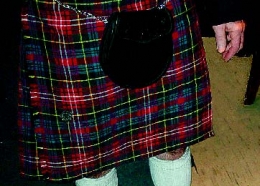Separated only by the North Channel and the Irish Sea, Scotland and Ireland are close in location, but seem culturally quite distinct to many outsiders.
Yet Irish student Theresa Boylan believes the opposite to be true.
Her mother is Irish and her father Scottish – an immigrant from Glasgow who moved to Ireland as a child 35 years ago. Influenced by both cultures, Boylan has become something of a Hiberno-Scottish expert, and reveals to Metro Éireann some of the elements that connect the cultures together.
When thinking about Scotland, one thing that usually comes to mind is the typical Scottish kilt. Yet it’s widely thought that the kilt as a traditional and ancient dress originated in Ireland, and was only later imported to Scotland. And it almost goes without saying, a kilt is not a skirt, whether in Scotland or Ireland.
“During my trip to Scotland there were two Americans tourists dressed in kilts and they were making a joke out of it,” recalls Boylan. “I warned them that it could offend Scottish people. Indeed, a Scottish man turned around and told them that they were racist and that they didn’t have a clue about what the kilts are about.
“Nevertheless,” she adds, “it’s funny that the Scots didn’t wear anything under their kilts in earlier times, the reason being that they wanted to offend the Brits by showing them their bums!”
Today, the kilt has a place in high fashion, and can often be admired on the catwalk as designers such as Jean Paul Gaultier, Vivienne Westwood and Glasgow’s own Jonathan Saunders take traditional Scottish dress to places the clan chiefs never dreamed of.
One particular historical aspect that links Ireland and Scotland closely together is their shared antipathy towards England.
“The English took over Scotland, but Scotland has always considered itself as a separate nation,” explains Boylan. “Ireland too has always considered itself as a separate nation.
“The history of the Scottish and the English is absolutely brutal; in Ireland it’s the same thing. The English killed off anybody that had power in the country.” She also notes how the English suppressed their closely-related native languages – Gaeilge to the Irish, Gaelic to the Scots.
Both nations are regarded in high esteem for their literature, celebrating the beauty of their respective lands (for example, the poetry of Yeats in Ireland, and Burns in Scotland). Storytelling has also played a major role in both cultures, and between them they have produced countless numbers of renowned prize-winning authors who have helped to shape the face of literature today.
In light of this, it’s no surprise that both Ireland and Scotland rely heavily on symbolism to express their country’s beliefs. For the Scottish, their national symbol is the thistle, which is regularly associated with the Latin motto ‘Nemo Me Impune Lacessit’ – ‘No-one provokes me with impunity’. Meanwhile, the Irish believe in the luck of the shamrock, a symbol that expresses St Patrick’s explanation of the Holy Trinity to the Irish people.
Sport also runs deep as a cultural obsession for both countries. Today, soccer – ironically a sport that originated in England – is the game that increases the solidarity between both countries, though it can also signal divisions (as the rivalry between the ‘Catholic Irish’ Glasgow Celtic and the ‘Protestant’ Rangers shows all too well). But traditional sports also have deep connections – the Scottish game of shinty, for example, is very similar to Irish hurling, while rugby is another shared passion.
And traditional music and dance share common roots. “Irish dancing is a lot of footwork,” says Boylan. “The way dancers kick their legs up would be quite similar [to Scottish step dancing]. Both countries are doing that to express the music of their culture. With the Irish, it’s always about the beat, and an expression of the conflict against the English.”
When it comes to alcoholic beverages, whiskey production ranks highly in both lands. While Ireland is especially famous for the products of the Jameson Distillery, the Scottish always have enjoyed the typical Scotch whisky – “spelled without an ‘E’,” says Boylan. “There are hundreds of different types of whisky in Scotland, and it is stronger than Irish whiskey.”
As for food, Scotland and Ireland are both renowned for their rustic cuisine. But aside from the obvious, such as the famous stew, one particularly Scottish food is haggis. “It consists of sheep’s pluck (heart, liver and lungs) minced with onions, oats and spices, and cooked in the sheep’s stomach,” explains Boylan. “It’s delicious!”












